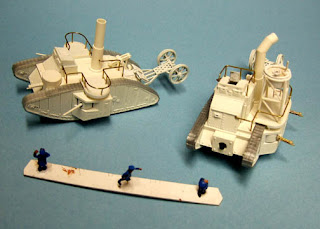The concept of the flyer (and most of my projects) came from simple doodles which usually evolve thru subsequent doodles. As I have said before, I like to let the project speak to me and let it develop as it progresses.
An historical project evolves via thought, sketches and construction largely in the material and techniques used to represent the known object. The design of a fantasy project can really be influenced by having a basic concept and letting the materials do some of the work. Just start building and let the project evolve. Try things out to find the “look" you are searching for. I have a box of plastic bits and model kit leftovers I have been nursing along for 30 years or more, so any project involves sifting through the bits an selecting parts that might be of use.
Though not originally planned, (and this is one of the beauties of the technique of letting the project evolve as you work with it) I had been doing some research on pre-dreadnought ships and early battleships and I have always like the “geodesic” masts on some of the early American battleships. I decided this type of mast would liven up the vast round blankness of the main deck. It would also form the support for the flying bridge and the propeller shaft.
Work on the tower began with making a light cardboard tube in the size and taper required. I basically rolled up a sheet of light cardboard (similar to the backing of a notepad) and glued it together. I then cut two rings of Evergreen 60 thou plastic. I drilled them for 12 uprights. I also drilled smaller holes, two at each upright,on slight angles. The smaller holes were in two concentric rings This allowed an inner “layer” of the uprights of 40 thou Evergreen styrene rod and two winding layers of 30 thou rod. One layer of the smaller rod spirals clockwise around the tube, while the outer layer spirals counter-clockwise.
I fitted the drilled rings onto the tube and taped the uprights in place. The uprights were longer than the finished tower and the tape held them in place to the cardboard form, outside of the construction area. I was then able to lace the spiral rods into place. The spirals go half way around (180 degrees) the form. When the whole thing was assembled, I took a narrow brush dipped into Tamiya liquid styrene glue and touched each of the intersections of the rods and the rings. The result, as was the intent of the historical structure, is a very light, yet very strong structure.
There was a bit of a scary moment when I thought the whole thing would collapse when I tried to remove it from the cardboard tube. The glue acts as a solvent and is very effective in gluing the styrene but also effective in gluing the styrene to the cardboard. I ended up using a pair of pliers to twist the cardboard into a tighter spiral to actually remove the cardboard from the inside of the tower structure.
At the front of the vessel there is a small gun tub for a crewman and some form of quick fire gun. Another of the concepts I try to stick by is utility. The doors do not have to open, but there have to be doors. Figures may not actually stand on ladders or stairways but it has to be clear how you get from one spot to the next. There will be a mast and a ladder up the middle of this tower, and a hatch at the top and a door at the hull-bustle to allow a crewman to get from the hull up to the crow’s nest.
So, you ask how does a guy get from the deck out to the gun tub? I envisioned a similar geodesic cage, like a ladder cage along the thicker tube with a cat walk out to the gun tub. As above, I made a smaller thinner card board former and cut rings and laced it carefully with very thin Evergreen rod. Unfortunately, the thin rod, under the stress of the bends, snapped when solvent glue was applied. The resulting mess, the waste of the materials and the time, was very frustrating. I have since sourced some model railroad ladder cages and will try those.
A larger geodesic structure was built for a docking tower and there was no problem with thicker Evergreen rod. The thin stuff is just too fragile. Maybe different glue...
Here is teaser shot of my VSF Zeppelin. Merry Christmas to all!


































